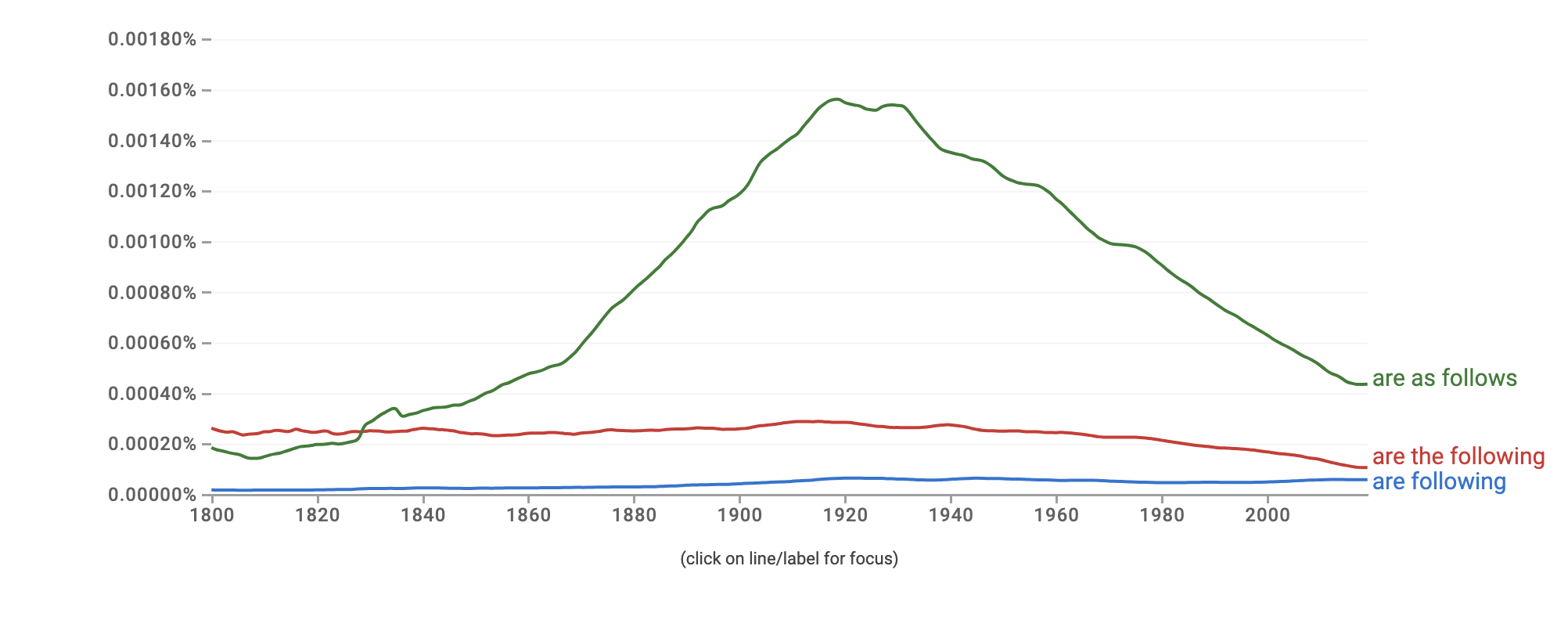- "Are Following" is a present continuous verb phrase used when describing ongoing actions or events. It implies that the subject is currently engaged in following a sequence or list.
- "Are the Following" is employed to introduce a specific list or set of items directly following the phrase. It adds a level of formality and structure to your sentence.
- "Are as Follows" is a formal expression used to introduce a list or series of items. It is often used in written or professional communication to provide a clear and organized presentation of information.
✍️ These are the following steps you need to take to complete the project.
✍️ The schedule for the conference is as follows: Registration at 8:00 AM, Opening Keynote at 9:00 AM, and Networking Lunch at 12:30 PM.
Ah, the humble list. It's a writer's bread and butter, a way to organize information and keep readers engaged. But when it comes to introducing those lists, things can get…tricky. Enter the three grammar titans vying for the introductory spotlight: "are following," "are the following," and "are as follows."
When to use "are following" vs. "are the following" vs. "are as follows"
Are Following:
- Use when: Your list involves a sequence of steps, instructions, or events happening one after the other. It emphasizes the order and action.
Examples:
- To assemble the furniture, the following steps are following: unpack the parts, identify the screws, attach the legs, and tighten the connections.
- The stages of grief typically are following: denial, anger, bargaining, depression, and acceptance.
Are the Following:
- Use when: Your list presents a collection of items or options without implying a specific order or action. It simply introduces the list neutrally.
Examples:
- The available toppings for your pizza are the following: pepperoni, sausage, mushrooms, onions, and peppers.
- The shortlisted candidates for the award are the following: Dr. Miller, Ms. Garcia, and Mr. Lee.
Are as Follows:
- Use when: You want to formally and ceremoniously introduce a significant list, often in official documents or announcements. It demands attention and sets the stage for something important.
Examples:
- The winners of the competition are as follows: first place, Ms. Jones; second place, Mr. Smith; and third place, Dr. Lee.
- The terms and conditions of the agreement are as follows:...
Bonus Tip:
- As follows: This phrase can also be used as a standalone phrase within a sentence to introduce a list, particularly in legal or technical writing.
- Example: "The contract states the following: payment terms as follows:..."
Examples from the web
Are Following:
"Other cities are following." - The Economist
"Others are following suit." - Forbes
Are the Following:
"Most important here are the following processes." - Encyclopedia Britannica
"Some of the issues are the following." - SEP
Are as Follows:
"The dangers are as follows." - Independent
'Those numbers are as follows." - The Guardian
Use "Are Following" for ongoing actions, "Are the Following" for introducing a specific list with added formality, and "Are as Follows" for a formal presentation of a list. Consider context, formality, and the need for clear organization in your communication.
Usage of "are following" vs. "are the following" vs. "are as follows"
"Are as follow" has occurred the most, with its peak use in the 1920s. "Are the following" is second most used, and the last is "are following."


FAQ
Does following mean before or after?
"Following" typically means after. It denotes a chronological sequence where one thing comes after another. In various contexts, it indicates the order or consequence of events or items, suggesting that what follows comes subsequently in time or sequence.
Does following mean immediately after?
No, "following" doesn't necessarily mean immediately after. While it implies a subsequent order, it doesn't specify an immediate connection. The term signifies a sequential relationship, but the timeframe between the two events or items may vary depending on the context.
Summary
Precision in language is paramount, especially when dealing with phrases that might seem interchangeable. Understanding the distinctions between "are following," "are the following," and "are as follows" empowers effective communication, ensuring that your message is conveyed with the intended emphasis and formality.

Want to sound like a native speaker?
Engram’s AI-powered grammar checker makes your English sound like a native speaker’s, suggesting natural English expressions on top of fixing grammar, spelling, punctuation, word order, and vocabulary.

References:















